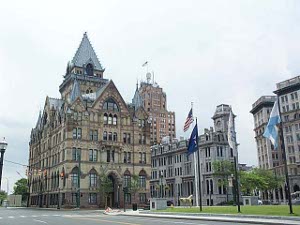 There's a horse on the lawn
There's a horse on the lawn
Compared with the Rocky Mountains or the Sierra Nevada, the Catskills seem like gently rolling green hills. This impression is deceptive; the roads still climb and twist and cut switchbacks, following Indian trails and maneuvering along the course of rivers and creeks, past lakes and reservoirs, and through deep forests. The driving is still demanding.
We find ourselves wondering how much of the northeastern forest land was once cleared and farmed, only to be allowed to return to its natural wooded condition. While the pioneers could farm rocky and hilly acreage as subsistence farms, today's farmer needs to make a profit, if only to purchase the tools and equipment he or she needs to keep farming. So the marginal farms of past centuries are now back to forests. Of course the Catskills themselves are occupied by 1.2 million acres of state-owned woodland. These are lovely mixed forests, with oak and birch and maple along with pines, spruces, cedars.
In New York City in April the mayor complained about the drought and turned off the fountains. We have seen some of his many water reservoirs in the Catskills, and they look pretty full. Also, it has been raining now for quite a few days, so perhaps he can let the fountains squirt again -- they do so improve everyone's spirits!
 There's a horse on the lawn
There's a horse on the lawn
Along the highway, fields are flooded and the shoulders are mushy and muddy. Cascades and waterfalls are full to overflowing. Wildflowers come in four colors (blue lupine, purple thistle, yellow dandelions, white Queen Anne's lace), pink rhododendrons sometimes massed beneath the tall trees. It's a good season for catalpa trees, too, with masses of white blooms and broad green leaves like the spades on a deck of cards. The weeping willows don't have noticeable flowers, but their distinctive shape and size makes them an eye-catching favorite.
We've been seeing more wildlife, too -- a total of eight deer in one day, in seven different sightings, along with one grouse at the side of the road. We were hoping for a black bear in the Catskills, but no luck. We did pass an ostrich and emu farm though -- our relatives had toured it last week.
It's nice to have beautiful woodlands, because many of these upstate New York towns aren't all that pretty. There seems to be too many older buildings, poorly built and more poorly maintained, country houses overflowing with rusted junk, tiny one-room vacation cabins, run down stores and restaurants. Everywhere we comment on the used-up buildings that haven't been torn down, but should be. It's a shame, because the well-maintained older homes are very attractive, with nice architecture and well-landscaped settings. Too bad if the house next door is a wreck.
Two hundred years ago, when there was lots of free land to be had, it seemed that people were much more willing and able to pull up stakes and relocate if the opportunities dried up where they were. But -- even though we are a highly mobile society today -- it seems that too many people just wait helplessly when a community starts going downhill. They draw unemployment and welfare and await the return of industry, which often doesn't happen. Why should some counties in the US have 20% unemployment while other counties have 1% unemployment?
We're stopping in Syracuse for a few days. Sunday we visited some museums. The excellent Erie Canal museum is located in a former weighlock building; a fast captain could float over a huge wooden cradle inside the building, wait while the water was drained out, the boat weighed, and the boat refloated, and be on his way again (towed by mules) in fifteen minutes. Although the State's tolls were relatively inexpensive, there was so much traffic that the State grew rich.
 Downtown Syracuse
Downtown Syracuse
Down the street is the Onondaga Historical Association Museum, which we also recommend highly. We learned that much of the Syracuse cargo was salt. The area around Syracuse was rich in brine, which could be evaporated and stored until the summer canal season. Due to the inexpensive transportation by canal boat, Syracuse supplied over half the nation's salt by 1850. The canal went right through the heart of the city, with buildings on both sides. Then the railroad came, parallel to the canal and a block away. In Syracuse the train cars went down the middle of the street until fairly recently. Eventually the trains put the Erie Canal out of business.
Syracuse boomed to 170,000 people back then, but the population has remained stagnant ever since. Salt, of course, provided very low-tech employment, but later Syracuse produced china and the Franklin automobile. Today Carrier and Bristol Meyers Squibb are the big employers, but the city is just holding its own, no better. The west side of town is quite depressed, with lots of boarded up buildings. Syracuse University does not seem to be nurturing a high-tech embryo. Perhaps the problem is just the cold and snowy winters.
As for local culinary traditions, the salt workers learned that a potato boiled in brine made a tasty lunch. We have learned of a hot dog place that still serves salt potatoes, and we're planning to eat lunch there one day. We'll keep you posted!
We have three sets of ancestors we're hunting in Syracuse. The first group moved here from western Massachusetts in 1800, the second group from eastern Connecticut in 1825, and the third group immigrated from Ireland in 1850. There's no indication that any of the three groups knew each other.